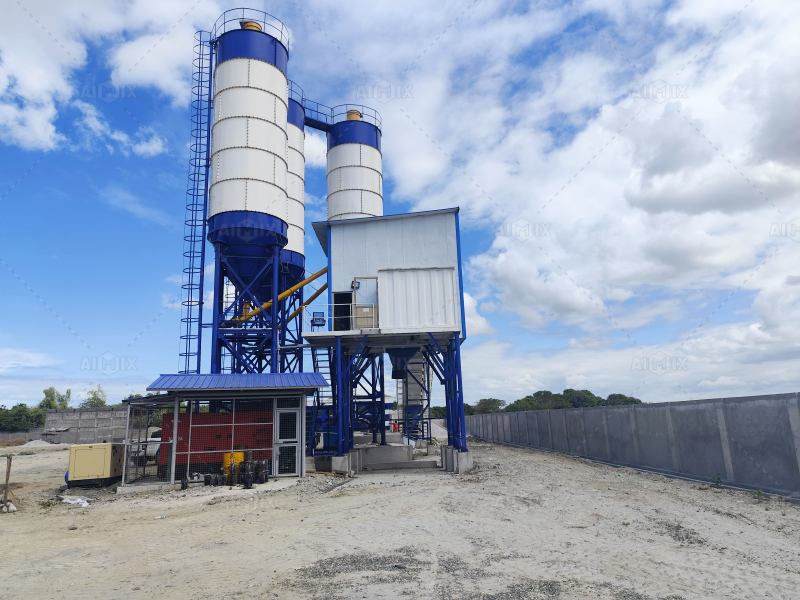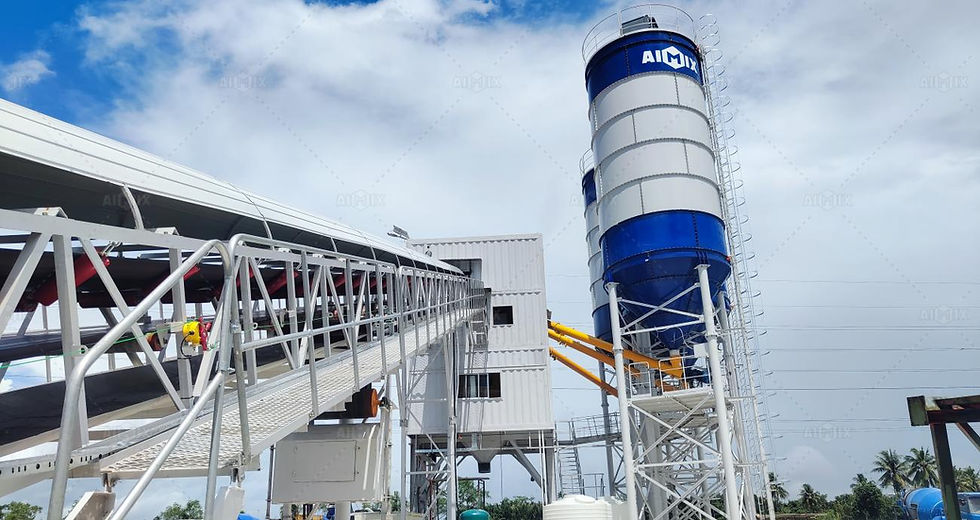Investing in Worker Safety: A Smart Way to Control Long-Term Concrete Batching Plant Cost
- aimixglobal5
- Nov 6
- 5 min read
Running a concrete batching plant business is not only about maximizing output and efficiency — it’s also about ensuring the health and safety of the workforce that keeps production running. For many producers, especially those operating in fast-growing industrial markets such as China batching plant manufacturers, investing in safety can seem like an additional expense. However, evidence from across the construction materials industry shows the opposite: prioritizing worker safety directly helps control the long-term concrete batching plant cost, improves operational stability, and enhances business reputation.

1. The Hidden Cost of Neglecting Worker Safety
The concrete industry involves numerous hazards — from heavy machinery, rotating mixers, and high-pressure systems to dust, noise, and electrical exposure. When safety systems are neglected, accidents can result in serious injuries, production downtime, equipment damage, and even legal penalties. Each of these outcomes adds hidden and often escalating costs to the business.
In the short term, an unsafe working environment may seem to save money by cutting corners on protective equipment or training. But in the long run, the economic impact can be severe. Insurance premiums increase, equipment repair costs rise, and production schedules get disrupted. In addition, workplace injuries can affect worker morale and lead to higher turnover, increasing the cost of hiring and retraining operators.
For a concrete batching plant business, even a small safety incident can halt production for days — affecting deliveries, customer satisfaction, and cash flow. The better alternative is to invest in preventive safety measures that lower both operational risk and long-term cost.
2. How Safety Investments Reduce Concrete Batching Plant Cost
The most successful China batching plant companies recognize that safety and efficiency are connected. By implementing well-designed safety systems, they reduce energy losses, maintenance requirements, and material waste — all of which help lower the total cost of a concrete batching plant.
Here are several ways safety investments create measurable savings:
Reduced Equipment Downtime: Automated safety sensors and interlocking systems prevent overloads, overheating, or mechanical collisions. This extends the life of critical components such as mixers, conveyors, and cement silos.
Lower Maintenance Costs: Safety routines often involve regular inspection and preventive maintenance schedules. Early detection of faults avoids major breakdowns, saving thousands of dollars in repairs.
Improved Efficiency: Well-trained operators handle materials more carefully and follow optimized procedures, reducing spillage, material waste, and energy consumption.
Regulatory Compliance: Meeting safety standards minimizes the risk of fines and shutdowns, ensuring smooth operations. This is particularly vital in countries with strict labor laws or environmental regulations.
These factors demonstrate that safety is not a cost burden but a key element of financial control in the concrete batching plant business.
3. Lessons from the China Batching Plant Industry
The China batching plant sector provides valuable insights into how safety-oriented design can improve long-term profitability. Chinese manufacturers have rapidly modernized plant technology over the past decade, integrating automation, dust collection, and digital monitoring systems into standard models.
Modern Chinese batching plants now feature enclosed mixing towers, centralized control systems, and automatic lubrication mechanisms — all designed to minimize human exposure to hazardous environments. These upgrades have significantly reduced accident rates and extended the lifespan of key machinery.
Moreover, many China batching plant producers promote safety as part of their brand value, exporting equipment that meets ISO and CE certification standards. For buyers worldwide, this ensures that purchasing a modern Chinese plant means acquiring not only high capacity but also safer and more efficient technology — both of which contribute to lower long-term concrete batching plant costs.

4. Integrating Safety into Business Strategy
For business owners, the most effective safety programs are those integrated into everyday management and training. Here’s how to achieve that:
Conduct Risk Assessments: Regularly analyze each stage of batching — from material loading to discharge — to identify potential hazards.
Provide Continuous Training: Operators must be familiar with emergency shutdowns, PPE usage, and equipment operation procedures. Consistent training keeps staff alert and minimizes human error.
Adopt Smart Monitoring Systems: Many China batching plant models include digital dashboards and sensor-based alerts. These systems notify managers of unusual vibration, temperature changes, or overloads before an accident occurs.
Enforce Maintenance Schedules: Preventive maintenance based on safety inspection reports ensures all moving parts function correctly, reducing the risk of sudden failures.
Encourage a Safety Culture: Reward teams that demonstrate responsible behavior and report near misses. A positive safety culture leads to proactive risk prevention rather than reactive damage control.
When these practices are institutionalized, they help the concrete batching plant business achieve a safer, more productive, and cost-efficient operation.
5. Safety Compliance as a Competitive Advantage
In today’s market, customers and regulators increasingly value sustainability and compliance. Demonstrating that your concrete batching plant business adheres to international safety standards enhances your reputation and helps you win contracts, especially with multinational developers or public infrastructure projects.
For example, contractors in Singapore, the Middle East, and Europe often require suppliers to meet ISO 45001 (Occupational Health and Safety) or equivalent standards. Having these certifications not only reduces the likelihood of penalties but also serves as a business advantage.
By comparison, China batching plant exporters that integrate safety and environmental compliance into their design often find easier entry into international markets. Buyers recognize that well-protected workers and safer operations translate to consistent product quality and dependable delivery schedules.
6. Long-Term ROI from Safety Investments
The return on investment (ROI) from safety improvements may not appear immediately but compounds over time. Over five to ten years, reduced accident frequency, lower maintenance costs, and higher employee retention collectively lower the total concrete batching plant cost.
Consider an example: A batching plant installs an advanced dust suppression and filter system. The upfront cost may increase by 5%, but the plant saves more than that in reduced filter maintenance, improved equipment reliability, and fewer health-related absences. In financial terms, safety translates into operational continuity — a critical factor for any concrete batching plant business seeking sustainable profitability.

Conclusion: Safety as Smart Economics
Investing in worker safety is not just a moral responsibility — it is a strategic financial decision. The long-term cost of a concrete batching plant depends on the efficiency and stability of its workforce and equipment. By integrating safety into design, training, and management systems, plant owners can minimize risk, improve productivity, and ensure steady returns on investment.
For the China batching plant industry, safety-driven innovation has become a hallmark of modern competitiveness. As global standards rise, companies that prioritize worker protection are positioned for long-term success. For any entrepreneur running or starting a concrete batching plant business, treating safety as an asset — not an expense — is the smartest way to control cost, secure growth, and build a sustainable future.







Comments